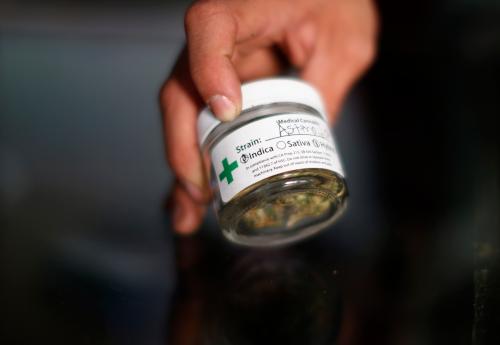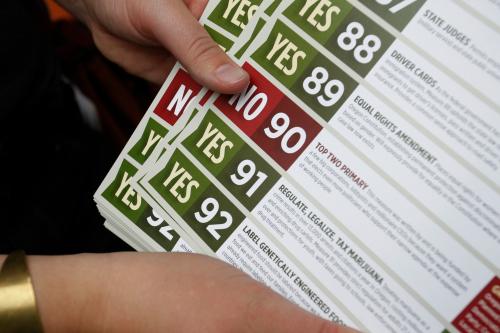I spent last week in the Greater Denver area researching implementation of legalized cannabis. In the process, I found a remarkable situation: a robust entrepreneurialism around an industry that elsewhere lives in the shadows of society.
In 48 other states in the US, members of an organization growing hundreds of cannabis plants under one roof would be arrested by state or local police and charged with serious felonies. Under Colorado state law, such behavior is perfectly legal, so long as it conforms to Amendment 20 and/or Amendment 64 to the Colorado Constitution, and the subsequent statutory and/or regulatory requirements on the cannabis industry.
The result is surreal. You can walk into a dispensary and purchase marijuana or request a tour of a nursery or farm that openly grows a product in violation of the Controlled Substances Act. In the coming months some of us here at Brookings will be researching the new marijuana industry, not as advocates, but as social scientists, interested in how our federal system comes to terms with statewide decisions to legalize a substance that is illegal in the rest of the country, and how states implement those policy changes.
Regardless of one’s personal feelings on the issue, Colorado has determined (and within bounds, the federal government has allowed) the construction of a legal, recreational, and highly regulated market by which consumers can purchase a vast array of cannabis products. And business is booming.
The term “marijuana industry” evokes very distinct images. It may be an image of a stoner growing plants in his basement or an obscure corner of acreage. It could be a high school student selling baggies of product from his car in a parking lot. Images harken back to Drug-Free America commercials with the rough looking, strung out drug dealer in an urban setting.
The Colorado model flies in the face of the stereotypes. . The legal market in Colorado, from professional grow operations to medical dispensaries to recreational dispensaries, looks nothing like street corner drug operation. These are professional businesses that are innovative and scientific. They bring black market lessons to the new, white market, while using tools of agriculture, engineering, science, manufacturing, and business to advance an industrial effort.
Businesses function in a market—though highly regulated—competing with each other to produce the best product in the highest demand. Surely there are members of the industry—like in any industry—who try to skirt the rules or operate outside of the regulatory structures. However, my interaction with businesses involved talking with executives, operators, and employees who embodied professionalism and care for their craft. They reminded me at every turn that they were quite aware that playing by the rules was a necessary condition to avoid the ever-possible federal intervention. At the same time, they showed pride in their efforts, just as a brewmaster would at a microbrewery or a vintner at a winery.
And the operations were just as scientific. For example, at the grow operation I toured, I was led through a series of rooms, engineered specifically for the growing of cannabis. The process involved water purification, testing pH levels, temperature, and conductivity. There was a genetics room where employees ensure a strain of marijuana is consistent in each subsequent plant of that strain. Lights (as it was an indoor grow) were metered, colored properly for the correct stages of growth, measured the proper distance from plants, and were shut off for the necessary periods of time each day. Feeding and watering were timed and measured, and every plant pinned with the state-required seed-to-sale tracking system identifier tags. While in some ways similar to a greenhouse where one would buy roses or petunias, this space looked nothing like the neighborhood florist’s supply space. It was a warehouse filled with advanced agro-science and manufacturing.
In addition, my visits to dispensaries and a grow operation offered a peek into the emerging labor market within the industry: it employs demographic groups hit hardest by the recent recession. Most employees were young (appearing 30 or under). There were numerous females and individuals of color. Though I lack systematic industry employment data and cannot make broad claims about employment trends, my conversations with those who know the industry best suggested that those observations were more than just anecdotes and reflect real trends among cannabis businesses.
Is the industry perfect? No. Does it need regulatory and legislative solutions to operate in a more effective, safe, and consistent way? Absolutely. I will address these topics in a paper to be released in the coming months.
However, a deep look into Colorado’s industry shows a professionalized marketplace that contrasts starkly with caricatures or stereotypes about marijuana growers and sellers. In Colorado, the marijuana seller may not look or dress the same as the woman selling pharmaceuticals or the man selling insurance, but they’re driven by similar entrepreneurial energy and a willingness to play by the rules in a regulated marketplace. The emergence of that marketplace, the ability of the state to respond to the unprecedented and unique challenges it will present, and its adaptation to the broader federal system will be the topics of more research.






Commentary
Dispatch from Colorado: The Interesting Case of Marijuana Entrepreneurs
May 22, 2014